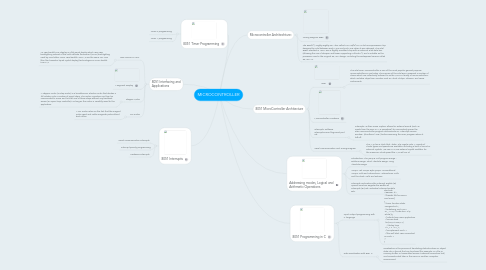
1. 8051 Timer Programming
1.1. Timer 0 programming
1.2. Timer 1 programming
2. 8051 Interrupts
2.1. Serial Communication interrupts
2.2. interrupt priority programming
2.3. Hardware Interrupts
3. 8051 Interfacing and Applications
3.1. LED,LCD,DAC,ADC
3.1.1. An LED-backlit LCD display is a flat panel display which uses LED backlighting instead of the cold cathode fluorescent (CCFL) backlighting used by most other LCDs. LED-backlit LCD TVs use the same TFT LCD (thin film transistor liquid crystal display) technologies as CCFL-backlit LCD TVs
3.2. 7 segment Display
3.3. Stepper Motor
3.3.1. A stepper motor (or step motor) is a brushless DC electric motor that divides a full rotation into a number of equal steps. The motor's position can then be commanded to move and hold at one of these steps without any feedback sensor (an open-loop controller), as long as the motor is carefully sized to the application.
3.4. DC motor
3.4.1. A DC motor relies on the fact that like magnet poles repel and unlike magnetic poles attract each other.
4. Microcontroller Architechture:
4.1. Timing Diagram 8086
4.2. The 8086[1] ("eighty-eighty-six", also called iAPX 86)[2] is a 16-bit microprocessor chip designed by Intel between early 1976 and mid-1978, when it was released. The Intel 8088, released in 1979, was a slightly modified chip with an external 8-bit data bus (allowing the use of cheaper and fewer supporting ICs[note 1]), and is notable as the processor used in the original IBM PC design, including the widespread version called IBM PC XT.
5. 8051 MicroController Architecture
5.1. 8051
5.1.1. The Intel 8051 microcontroller is one of the most popular general purpose microcontrollers in use today. The success of the Intel 8051 spawned a number of clones which are collectively referred to as the MCS-51 family of microcontrollers, which includes chips from vendors such as Atmel, Philips, Infineon, and Texas Instruments.
5.2. Microcontroller Hardware
5.3. Interrupts: Software interrupts,Timer flag,Serial port etc
5.3.1. Interrupts, as their name implies, allows for external events (such as inputs from the user or AVR peripheral) to momentarily pause the main microcontroller program and execute an "Interrupt Service Routine" (shorthand "ISR") before resuming the main program where it left off.
5.4. Serial Communication and Timing Diagram
5.4.1. The AVR has a clock that “ticks” at a regular rate. A variety of clocks types and speeds are available, including a built-in circuit or external crystals. We use a 16MHz external crystal oscillator for the maximum clock speed the AVR will run at
6. Addressing modes, Logical and Arithmetic Operations
6.1. Introduction, The jump & Call program Range : Relative Range, Short Absolute Range, Long Absolute Range,
6.2. Jumps : Bit Jumps, Byte jumps, Unconditional Jumps, Calls and Subroutines : Subroutines, Calls and the Stack, Calls and Returns,
6.3. Interrupts and Returns,the Interrupt Enable (IE) Special Function Register,the Enable all interrupts (EA) Bit, Individual Interrupt Enable Bits.
7. 8051 Programming in C
7.1. Input Output programming with C language
7.1.1. #include <REGx51.h> //header file for 89C51 void main() { //main function starts unsigned int i; //Initializing Port1 pin1 P1_1 = 0; //Make Pin1 o/p while(1){ //Infinite loop main application //comes here for(i=0;i<1000;i++) ; //delay loop P1_1 = ~P1_1; //complement Port1.1 //this will blink LED connected on Port1.1 } }
7.2. Data Serialization with 8051 C
7.2.1. serialization is the process of translating data structures or object state into a format that can be stored (for example, in a file or memory buffer, or transmitted across a network connection link) and reconstructed later in the same or another computer environment
